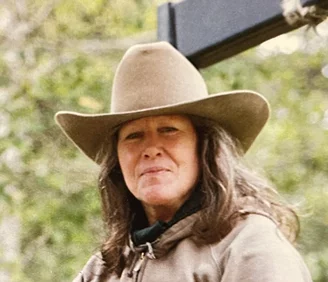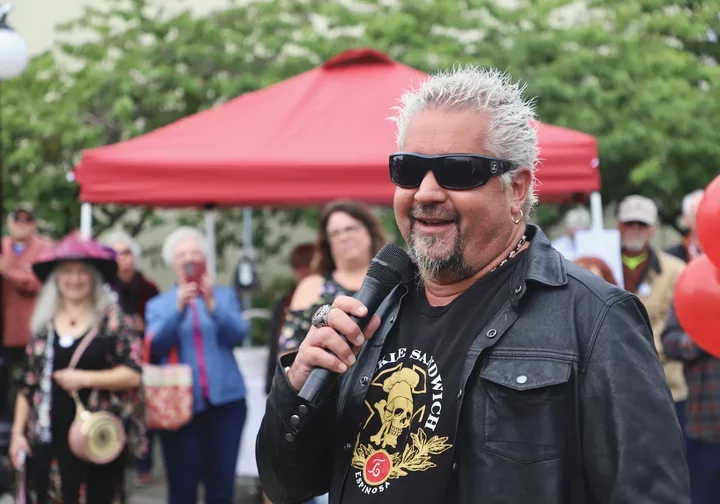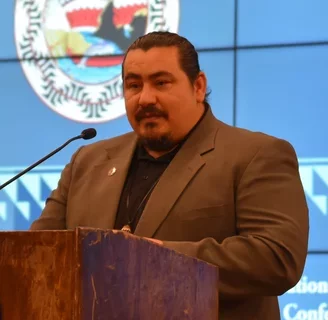Which Fast Food Workers Will Get Paid More in California?
Jeanne Kuang / Thursday, March 28, 2024 @ 12:46 p.m. / Sacramento
Gov. Gavin Newsom stands with cheering fast food workers after signing legislation raising their minimum wage in Los Angeles on Sept. 28, 2023. Photo by Alisha Jucevic for CalMatters.
Say you work at a fast food restaurant or coffee shop that bears the name of a national chain. Under California law, you’re entitled to be paid at least $20 an hour starting Monday.
Say you work at one of those stores, inside a grocery store. The grocery store, your employer, is exempt under the law. You’ll keep getting your current wages.
But say you assemble burgers, scoop ice cream or prepare Frappuccinos at one of those stores, and it’s inside another store, but the bigger store isn’t a “grocery” because less than half of its revenues are made off groceries. What then?
According to the state of California, the store should be paying you at least $20 an hour, but only for the hours you work in the fast food portion of the store. If you spend part of your shift checking out customers or stocking the shelves in the rest of the store, you’re only entitled to the regular minimum wage of $16 for those hours.
That’s according to an 18-item FAQ the Department of Industrial Relations published in March as California businesses prepare for the fast food minimum wage to kick in on Monday.
It’s not the only situation that is confusing employers and workers alike.
To raise wages for fast food workers, the Service Employees International Union struck a deal last year with the International Franchise Association and California Restaurant Association that included owners of fast food chain locations but exempted those who operate independent restaurants.
The law covers all fast food restaurants that belong to chains with 60 or more locations nationally, roping in the unions’ targets: McDonald’s or Burger King and their franchise owners. More than 500,000 Californians — primarily women, immigrants and people of color — work in what’s known in the industry as “limited service restaurants.” Earlier this year SEIU estimated the law will apply to roughly 3,000 employers.
“The vast majority of fast-food locations in California operate under the most profitable brands in the world,” Joseph Bryant, SEIU’s executive vice president and a member of a new statewide fast food regulatory council, said in a statement today. “Those corporations need to pay their fair share and provide their operators with the resources they need to pay their workers a living wage without cutting jobs or passing the cost to consumers.”
But outside those national chains are numerous other food sellers and business arrangements, not all of which are directly addressed in the new law. Grocery stores and some bakeries are exempt, and this week, Gov. Gavin Newsom signed into law a carve-out for fast food places at airports, convention centers and hotels.
According to emails obtained by CalMatters in response to a public records request, a range of employers have been trying to figure out if they must pay $20 ever since the law was signed late last September.
In October, the Department of Industrial Relations received two inquiries from franchise owners asking whether they must comply with the law. One employer owned an Auntie Anne’s and a Cinnabon and believed selling pretzels and cinnamon rolls qualified them for the controversial bakery exemption. The other owned an ice cream parlor.
“This clarification is imperative as to whether or not we will be financially able to open more locations at the proposed wage increase to $20 an hour,” the ice cream store owner wrote.
Both were forwarded to the department with a request for legal guidance by a staffer for Assemblymember Chris Holden, the law’s author. In recent weeks, Holden has been unable to answer reporters’ questions about why certain exemptions — such a carveout for some bakeries — were included in the law. The department redacted responses to those emails under a public records exemption for attorney-client communications.
By December, employers were lawyering up.
Attorneys for the Honey Baked Ham chain asked whether it would qualify. They described the stores as “retail meat stores” where customers primarily buy cooked hams and other “bulk proteins” and sides to eat at home, but acknowledged they also sell sandwiches that customers can eat at the restaurants or take to-go.
Attorneys also sought clarification over whether their clients would have to pay $20 if they own a chain of Papa Murphy’s “take and bake” pizza shops.
In late December, attorneys for an unnamed retail chain asked the department whether they would have to pay $20 in the fast food restaurants or cafes that are inside some of its stores. The attorneys noted the company’s stores sometimes sell groceries, but not primarily, and employees who work the fast food counters are often also assigned to other parts of the store.
Department attorney Ehud Appel said it did not respond to individual inquiries, instead answering to the companies with the FAQ this month.
In the FAQ, the state said: businesses are not exempt for selling ice cream, even though a national industry classification system excludes some ice cream shops from the definition of fast food, or “limited service” restaurants. To count as a bakery, the state said, the bread sold must weigh at least half a pound. And workers at a “store within a store” must be paid $20 for the hours they work in the restaurant portions of the stores.
The answers apparently created new questions.
The FAQ stated fast food managers can only be exempt from California’s overtime pay laws if they make more than twice the minimum wage — a threshold that is now higher for fast food employees. But attorneys for the retailer wrote in another letter to the department in mid-March that the stores’ managers only manage the fast food counters part time.
It’s unclear how the state will handle the confusion going forward.
Its FAQ directs workers who believe they’re wrongly being denied $20 an hour to file a wage theft claim with the Labor Commissioner’s Office — a process that is so backlogged amid a staffing crisis for the office that complaints can take years to resolve. The department did not immediately respond today when asked for further clarification.
The new fast food council may also take up the concerns, or they could end up in the courts to decide.
###
CalMatters.org is a nonprofit, nonpartisan media venture explaining California policies and politics.
BOOKED
Today: 4 felonies, 14 misdemeanors, 0 infractions
JUDGED
Humboldt County Superior Court Calendar: Friday, Dec. 5
CHP REPORTS
No current incidents
ELSEWHERE
100% Humboldt, with Scott Hammond: #100. From Police Logs to Community Legacy with Editor Kevin Hoover
HipHopHumboldt: Episode 68 - Rick Toledo
Governor’s Office: Governor Newsom proclaims Pearl Harbor Remembrance Day
79-Year-Old Eureka Man Killed in Solo Vehicle Crash Near Humboldt Hill Yesterday
LoCO Staff / Thursday, March 28, 2024 @ 12:02 p.m. / Traffic
Press release from the California Highway Patrol:
On March 27, 2024 at approximately 1241 hours, CHP Humboldt Communications Center received a report of an overturned vehicle on Northbound US-101, near the Humboldt Hill Road offramp. Emergency personnel responded to the scene and located a 1998 Nissan Pathfinder had overturned and subsequently come to rest on its wheels. The driver, 79-year-old Dennis Katri of Eureka, had unfortunately sustained fatal injuries as a result of the crash and appears to have been the only occupant of the vehicle at the time of the crash. A preliminary investigation indicates that, for unknown reasons, Mr. Katri allowed the Pathfinder to travel into the center median prior to traveling back on to the road and overturning. Impairment is not considered to have been a factor.
The California Highway Patrol extends its sincere condolences to the family and thanks all responding agencies for their assistance in managing the scene. The CHP Humboldt Area office is continuing its investigation and asks anyone who may have additional information to contact the California Highway Patrol at 707-822-5981.
Eureka Apartment Fire Displaces 20 Residents; Damages Estimated at $500,000
LoCO Staff / Thursday, March 28, 2024 @ 11:02 a.m. / Fire
Press release from Humboldt Bay Fire:
Late in the evening of March 27th at approximately 11:50 pm, Humboldt Bay Fire responded to a structure fire in an apartment building on the 400 block of L St. in Eureka. Three engines, one truck, two Chief Officers, and one Fire Support Volunteer responded.
The Battalion Chief arrived to find heavy fire coming from a window on the second floor of a 3-story apartment with multiple occupants still inside the building. A second alarm and second ambulance were requested, drawing two more engines to the scene and for station coverage. The first-arriving engine immediately located a victim in a 2nd floor window who was trapped in his apartment. The victim was quickly rescued through the window utilizing a ground ladder. Additional crews knocked down the fire in the fire apartment window from the exterior and made entry, locating three additional victims who were sheltering in place inside their apartments on the second floor. Firefighters assisted the three residents out of the building rescues and cleared the floor of any remaining occupants. The residents did suffer some smoke inhalation but reported no injuries and refused treatment.
The fire was controlled within 20 minutes with crews containing the fire to the original apartment. Quick actions by arriving crews prevented the fire from spreading to additional apartments, rescue the trapped victims, and ensure all occupants were safely out of the building and accounted for. Incident Commanders worked with the property owner and PG&E to isolate and restore utilities back to the building.
There were no firefighter or civilian injuries. Unfortunately, one pet was found deceased Smoke Alarms Save Lives. inside the fire apartment and another pet is still missing. 12 apartments were deemed uninhabitable due to fire, smoke and water damage, displacing approximately 20 tenants. Red Cross was brought in to provide the tenants with temporary housing and living needs. Damage to the building, valued at $5 million, is estimated at approximately $500,000. After investigation, the fire was determined to be caused by improper discarding of burnt aroma materials.
Humboldt Bay Fire reminds all occupants to soak any aroma materials, such as incense sticks, in water before discarding them and ensure you have working smoke alarms in all bedrooms and hallways. Early detection can save lives.
Humboldt Bay Fire would like to thank City Ambulance, Eureka PD, Red Cross, Arcata Fire and Samoa Fire for their assistance on this incident, and in providing station coverage.
###
OBITUARY: Erin Diana Jarvis-Nessier, 1960-2024
LoCO Staff / Thursday, March 28, 2024 @ 6:56 a.m. / Obits
It is with profound sadness and a shattered heart that we announce the passing of loving
wife, mother, friend, and soulmate Erin Diana Jarvis-Nessier. Our princess passed on January 2,
2024, peacefully cradled within the arms of her husband, may God rest her soul. Her son, Beau,
was also present, outside amongst her beloved forest.
Erin wore many earthly hats, but even on the darkest of days she never lost her resounding faith. Like the warrior she was, Erin fought her own battles with the same tenacity and personal drive she exhibited in every other area of her life, encompassed with immeasurable love and strength.
Erin was born in Redwood City, California, to parents Elwood and Sylvia Jarvis, on April 23, 1960. After graduating college, she succeeded in a plethora of professions. From full charge bookkeeper and office manager, to certified advanced veterinary technician and surgical assistant- she even spent time training police K-9s for several Bay Area and state law enforcement agencies. Erin was raised under the wing of her brother, Kevin Jarvis, who painstakingly took the time to teach her how to play a guitar. Erin was a wonderful musician, also blessed with a beautiful voice.
Up until being diagnosed with inoperable terminal cancer, Erin energetically swam several miles per day in an open water facility for her own enjoyment. She also rode her beautiful horse Rio, always trailed by her loving doggies Manley and Zipper. Nobody can sit a horse quite like Erin Jarvis. Nobody. She had a genuine love for all animals, especially rescues such as her beloved canines.
Erin will be remembered far into the future as the sole custodian of her forest. Her forest companions were her German Shepherds, Great Pyrenees, and the two ravens whom she had mastered the ability to communicate with. Erin was an avid nature enthusiast, as all those who knew her can attest. Erin brought with her a piercing light of love and warmth for all to share within. She had envisioned opening up her forest to kids of all ages, wanting to create an environment in which to teach the mysteries of coastal forests and the survival skills she had mastered.
Our princess’s difficult six-year battle with cancer and the staggering physical and mental challenge of her diagnoses with breast, spinal, and liver cancer is now through. Erin is now forever home with our Heavenly Father. Throughout this upsetting period of constant pain, chemotherapy, and radiation treatments, it was still not uncommon to find Erin wandering the trails throughout her forest, marking damaged trees for removal or treatment.
Erin was at home on her John Deere 6320, just as capable on the machine as she was at being the prettiest girl at the symphony. Being a country girl was a way of life for Erin. She was also a champion for those in need, carrying a special place in her heart for those going without. She knew how to make people laugh at themselves, even total strangers. Erin’s life reflected everything that was good, right, and true. Our little Irish Girl time and time again advocated for her little family, as they weathered many unforeseen challenges, disappointments, and times of sadness. She just as openly embraced the victories, giving each of her loved ones undivided attention without hesitation. Erin’s devotion was unconditional.
So dearly missed will be her many nicknames for her husband, Robert. But the memories of these names (Handsome Head, Weedhopper, Pokémon), still warm our hearts. Erin was Robert’s greatest joy, strength, his greatest blessing in life — taken too soon. Erin’s last words, delivered to her husband, were, “I love you so much.”
In this time of immense grief and sorrow, we are so grateful for the outpouring of love from friends, family, and everyone else in the community that has reached out and offered their support. Erin gave us all many cherished memories, a gift that will endure long after she has left this world. Erin firmly believed that we live in a compromised world. But she also believed the world was a place of profound beauty, wonder, adventure, and true compassion. Above all else, Erin carried an unwavering belief in the written word and promises of our Heavenly Father. Our lives will never ever be the same without Erin Diana Jarvis-Nessier.
Erin is survived by her Handsome-Head husband Robert, her loving son Beau Jarvis, brother Kevin Jarvis, and many nieces, nephews, and good friends.
Our family would like to express our deep thanks to the following persons and institutions for caring so deeply for our Little Irish Princess. A gracious heartfelt thanks to the Hospice of Humboldt, Dr. Connie Basch, Dr. Dosten MacDonald, Sandy and Barb from the oncology suite, Laurie Ervin and Ray, Rob and Sheri Gurney, Dr. Tony Anagnoston, Dr. Abdali and Dr Crabtreee, Dr. Elie Richa, Dr Howard Fellows, Dincy Corning, Keith Wininger of Wininger Farms, Travis Harmon, Josh and Leath Maveety, Mike Osborne, Dr. Marshall of UCSF Oncology, Andrew Livolsis, Pastor Dennis Murray, Jim and Ida Lowe, and Katie and Miriam Wheeler. We know there are many, many to thank for custodianship of Erin during this journey not listed. We thank you from the bottom of our hearts.
An outdoor celebration of life planned, regardless of weather, for April 20, 2024, noonish to lights out. The celebration may include spreading of ashes, light trail work, and the planting of redwoods, accompanied by love, fellowship, and good vibes. A favorite dish or beverage is welcome. You can contact Robert via email at opuskahn49@gmail.com. Ayers Family Cremations is handling all funeral arrangements. In lieu of flowers, donations to the Sequoia Humane Society or another charity of your choosing will honor Erin’s memory. God Bless you all.
“We Shall Pass this way on Earth but once. If there is any kindness we can show, or good art we can do, let us do it now, for we will never pass this way again.” -Stephen Greer
###
The obituary above was submitted on behalf of Erin Jarvis’ loved ones. The Lost Coast Outpost runs obituaries of Humboldt County residents at no charge. See guidelines here.
Guy Fieri, aka ‘The Mayor of Flavortown,’ to be Recognized as Honorary Mayor of Ferndale
Ryan Burns / Wednesday, March 27, 2024 @ 5:14 p.m. / :)
The hair. | File photos by Andrew Goff.
###
Ferndale native, humanitarian and famously charismatic food-eater Guy Fieri, already known as “The Mayor of Flavortown” and one-time “Mayor of Spicy Wings,” will soon add a third mayorships to his roster: On April 5, he’ll be crowned the honorary mayor of his own hometown.
The official proclamation, signed by actual Ferndale Mayor Randall Cady, reads as follows:
PROCLAMATION
Declaring
APRIL 5th
Guy Fieri Day
WHEREAS: Guy Fieri, who grew up in the city of Ferndale, is a celebrated chef, restauranteur, best-selling author and Emmy Award winning TV host.
WHEREAS: Mr. Fieri has always had a special connection to Ferndale since he started his very own pretzel cart at the age of 10.
WHEREAS: Mr. Fieri has continued to give back to our community through serving thousands of meals to hospital workers and firefighters as well as co-creating the Restaurant Employee Relief Fund.
WHEREAS: Mr. Fieri has become famously known as the Mayor of Flavortown.
WHEREAS: The City of Ferndale will always have a special place in our hearts for Mr. Fieri.
NOW, THEREFORE, I, RANDALL CADY, as Mayor, and on behalf of the City Council of the City of Ferndale, proclaim April 5, 2024, and every April 5” thereafter, Guy Fieri Day and on this day, the title of Honorary Mayor. We thank Guy for his positive impact on the City.
Given under my hand and the seal of the City of Ferndale, California on this 15 day of February 2024.
Here’s an Instagram post from the Ferndale Chamber of Commerce making the announcement:
Congrats, Guy!
Federal Officials, Developers Call for Collaboration with North Coast Tribes Amid Growing Opposition to Offshore Wind Development
Isabella Vanderheiden / Wednesday, March 27, 2024 @ 2:31 p.m. / Offshore Wind , Tribes
File photo via Principle Power.
###
Several North Coast tribes have announced their official opposition to the floating offshore wind project slated for the North Coast, citing “grave concerns” about potential risks to marine ecosystems and the sustainability of industrial-scale renewable energy projects.
But does that mean that tribes are walking away from negotiations? And what impact does tribal opposition have on the future of offshore wind?
“This Was Not an Easy Decision”
The National Congress of American Indians (NCAI), the largest national organization of American Indian and Alaskan Native tribal governments, last month passed a resolution urging the Biden Administration to “halt all scoping and permitting for offshore wind projects until completion of a comprehensive and transparent procedure adequately protecting tribal environmental and sovereign interests is developed and implemented.”
This statement was quickly echoed by the Yurok Tribe, the Bear River Band of the Rohnerville Rancheria and the Tolowa Dee-ni’ Nation, whose tribal councils voted to formally oppose offshore wind development on the North Coast. The Cher-Ae Heights Indian Community of the Trinidad Rancheria Tribal Council approved a similar resolution just a few days ago.
The Resighini Tribe of Yurok People has also expressed concern about potential “cultural and environmental impacts” associated with the proposed project but has not taken an official position as of yet. “The current leases are within the Tribe’s unceded, ancestral waters and the Tribe prioritizes Tribal stewardship and marine protection,” according to a statement shared by the Tribe.
[UPDATE: Shortly after publication, the Outpost received an email from the Resighini Tribe of Yurok People announcing the Tribal Council’s recent decision to formally oppose offshore wind development “until those serious concerns can be addressed.”]
If the project is approved in the years to come, the Humboldt Wind Energy Area (WEA), located approximately 20 miles west of Eureka, could host hundreds of floating wind turbines across 200 square miles of deep ocean waters.
U.S. Secretary of the Interior Deb Haaland and Congressman Jared Huffman are visiting Humboldt County this week to meet with local tribes and hear their concerns, according to a recent report from the North Coast Journal.
“I’m very concerned about this issue, and I need to visit with the tribes and hear a little more about their position and its implications,” Huffman told the Outpost in a recent phone interview. “I don’t think anyone wants to see offshore wind or any other project run roughshod over tribal interest – that is the last thing I would support. I have been very supportive of this project because I believe it can be done in a way that’s quite positive for the entire community, including the tribes.”
Asked whether tribal opposition to offshore wind development could halt the proposed project, Huffman said, “I don’t know if it would stop it, but it certainly complicates the tribal consultation process and other aspects moving forward.”
“I really want to hear them out, and I want to see how I can lean in to make sure that the federal government, the wind developers and everyone else does a better job in their tribal consultations,” Huffman continued. “I’d like to find out what the tribes might be able to get out of these projects. … There are some community and tribal benefits on the front end through the auction proceeds, but longer term – in terms of royalties – there are not. We need to fix that for the long haul so that communities and tribes have an incentive to partner in these offshore wind projects.”
Activists protest at the Tribal Offshore Wind Summit. Melissa Star Myers (right) holds a sign that says, “Green Energy is a lie! Protect [the salmon, the seaweed, the sturgeon, the seagulls].” Photo: Isabella Vanderheiden.
The Yurok Tribe held a two-day offshore wind summit in Eureka earlier this year to discuss all aspects of the proposed development and the importance of including indigenous communities throughout the planning process. Representatives from the Bureau of Ocean Energy Management (BOEM), U.S. Department of Energy, Vineyard Offshore and Canopy Offshore Wind were in attendance, along with several tribal leaders from the East Coast who described their experiences in working with regulatory agencies and developers on an offshore wind project located off the coast of mainland Massachusettes.
Yurok Vice Chairman Frankie Myers said the “powerful testimony” shared by members of the Mashantucket Western Pequot Tribe, the Wampanoag Tribe of Gay Head (Aquinnah) and the Mashpee Wampanoag Tribe influenced the Yurok Tribe’s decision to oppose offshore wind.
“This was not an easy decision for the Tribe,” Myers told the Outpost in a recent phone interview. “We have tried to be open and neutral about our position for offshore wind because we as a collective community don’t have a really clear picture of what it’s going to look like, but we have a responsibility to our membership. … I think our decision ultimately came down to just not having enough information.”
Myers acknowledged the importance of moving away from fossil fuels to address growing concerns surrounding climate change but said the North Coast does not need another extractive industry.
“Sometimes I feel like I’m taking crazy pills. Like, how many times do we have to have this conversation … and expect that we’re going to have a different outcome?” Myers asked. “We know climate change is having an impact right now and we know it’s going to get worse. … We may be able to move away from burning fossil fuels but if the industrialized offshore development ends up destroying our ocean ecosystem, then where do we sit? We don’t know 100 percent that that’s going to happen, but … we know for certain that there will be impacts. We can’t destroy our world to protect our world.”
That being said, Myers emphasized that tribal leaders “aren’t gonna go bury our heads in the sand” and will continue to participate in future discussions with regulators and developers.
“This isn’t a victory for us,” he added. “I think our members were happy that we took a stance in opposition, but no one thinks that stopping offshore wind is a victory. We know we have to do something, that we have to find an alternative energy source that allows us to move away from fossil fuels because of the impacts that we’re seeing within our communities.”
Regulators Call for “Meaningful Dialogue”
Reached for additional comment on the matter, BOEM spokesperson John Romero offered assurance that the federal government has “taken coordinated actions to incorporate indigenous knowledge and tribal input into [its] decision-making process.”
“BOEM is committed to upholding our tribal trust responsibilities and fostering working relationships based on trust and meaningful consultation and we are always working to improve the consultation process to engage Tribes in a respectful way,” Romero wrote in an emailed response to our inquiry. “We are interested in discussing how Tribes envision improvements to the process.”
The offshore wind leases auctioned off in December 2022 include several conditions and stipulations requiring developers to make communications plans with tribal nations. The lease agreement also includes a five percent credit for developers who committed to Community Benefits Agreements (CBAs) with tribes, communities and stakeholder groups “whose use of the lease areas or use of the resources harvested from the lease areas is expected to be impacted by offshore wind development.” The agreement includes a five percent general CBA as well.
Romero also pointed to several studies conducted through BOEM’s Environmental Studies Program, including tribal cultural landscape assessments and an Archaeological and Biological Assessment of Submerged Landforms off the Pacific Coast.
“It is important to BOEM that we consider any potential impacts to Tribes,” Romeo said. “We will continue to consult and engage with Tribes throughout the process and remain committed to exploring improvements to the process along the way.”
Similarly, the developers – Canopy Offshore Wind and Vineyard Offshore – underscored the importance of “meaningful” collaboration with tribal nations throughout the planning process.
“From the very beginning of our work in California, we recognized the importance of meaningful dialogue and building relationships with Tribal Nations, through engagement with Tribal Councils, leaders, and members,” according to a statement shared by Vineyard Offshore Spokesperson Andrew Doba. “We’re honored to have engaged in early conversations and look forward to continuing those discussions moving forward.”
Ciara Emery, Canopy Offshore Wind’s local government and stakeholder engagement manager, added that the company is “open to many forms of collaboration” with tribal nations, including partnerships. However, it is still very early in the development process, which is likely to extend over the next decade, she said.
“[W]e want to take the time to build these relationships,” Emery wrote in an emailed response to the Outpost. “The Canopy team has had dozens of meetings with tribal nations up and down the coast and is eager to continue listening and exploring ideas to foster mutually beneficial outcomes. … There is time to continue important conversations, respond to feedback and deepen collaboration.”
###
PREVIOUSLY:
- At a Two-Day Conference in Eureka This Week, North Coast Tribes Advocate for ‘Meaningful Engagement’ With Offshore Wind Developers, Federal Regulators
- Yurok Tribal Council Votes to Formally Oppose Floating Offshore Wind Energy Projects Along the North Coast
- Bear River Tribal Council Joins Yurok in Formally Opposing Offshore Wind Development Along the North Coast
- Trinidad Rancheria Becomes Latest Tribal Entitiy to Register Opposition to Offshore Wind
High Stakes: Inside the Multimillion-Dollar Battle for Gambling Rights in California
Ryan Sabalow and Jeremia Kimelman / Wednesday, March 27, 2024 @ 12:56 p.m. / Sacramento
A card room at Commerce Casino in Commerce on March 14, 2024. Photo by Ted Soqui for CalMatters
Powerful tribal casinos and their rivals in California’s multi-billion dollar gambling industry are fighting an epic battle in the Legislature this year. Millions of dollars in tax revenues for local cities hang in the balance.
Pending legislation would let California’s tribes sue their competitors, private card clubs, over their claim that card rooms are violating the tribes’ exclusive rights to Las Vegas-style gambling.
Card rooms have responded with an enormous lobbying blitz. The Hawaiian Gardens Casino in Los Angeles County spent a staggering $9.1 million on lobbying last year, the second highest amount reported to state regulators. Only the international oil giant, Chevron Corp., spent more.
“If you’re going to attack us and try to take away what we’ve had for decades, then we’ve got to fight back,” said Keith Sharp, the card room’s general counsel. “And so we’re going to spend the money that we need to spend. I mean it’s about survival at this point.”
Cities also have a lot at stake with the card rooms. San Jose officials told legislators they could hire 80 police officers if they could add 30 more tables to their local card rooms. Nearly two thirds of the budget for the city of Hawaiian Gardens and almost half for the city of Commerce, also in Los Angeles County, come from local card rooms.
“Those games, we’re very dependent on here in the city,” said Commerce Mayor Hugo Argumedo. “They provide many of the programs and services that we offer to the residents in our community.”
The legislation, Senate Bill 549, is backed primarily by a group of Native American tribes that run major casinos. The tribes are among the most influential and biggest spending lobbies in Sacramento. Since 2014, California’s candidates for state office have received about $23.5 million from tribes. That’s more than double what oil companies have given the state’s politicians during the same years.
The state’s card room industry, by comparison, has donated about $3.8 million during the same timeframe.
A group of tribes contend the 80 or so privately-owned gambling halls are illegally offering games such as blackjack, baccarat and pai gow poker, and by doing so, they’ve for years been stealing hundreds of millions of dollars of revenue from historically disenfranchised tribal communities across California.
“It’s not about killing card rooms. It’s not about killing cities. It’s about protecting what’s ours,” Tuari Bigknife, the attorney general for the Viejas Band of Kumeyaay Indians, told CalMatters. His tribe operates a large casino in San Diego County.
SB 549 is pending before the Assembly Governmental Organization Committee, which handles gambling legislation. A hearing hasn’t been scheduled, but those following the bill say it will be heard later in April or in May.
Card rooms frame the issue as a David vs. Goliath fight, since their annual earnings are barely 10% of what tribal governments make from gambling at their 70 tribal casinos. The card rooms also have influential allies in local governments officials who say their cities could go bankrupt if their local gambling hall loses this legislative fight.
When the pandemic shut down gaming in Hawaiian Gardens, the city was forced to lay off much of its staff and cut services. Mayor Victor Farfan said it was a sign of what would happen if the card room was no longer able to play the disputed games.
“We’re very, very limited in what we can do,” Farfan said in an interview with CalMatters at Hawaiian Gardens City Hall, the card room visible from the parking lot. “And so we’re fortunate enough to have a revenue source that we do today.”

Mayor Victor Farfan at Hawaiian Gardens City Hall in Hawaiian Gardens on March 14, 2024. Photo by Ted Soqui for CalMatters
Tribes, however, argue there are other ways for cities to raise money without infringing on tribes’ gambling rights that California voters enshrined into the state’s constitution.
“They can tax; they can issue bonds; they can do lots of things,” said Bigknife, the attorney general for the Viejas tribe. “All this does is shut down illegal revenue.”
Gold Rush gambling rules fuel conflict
The gambling dispute has roots in the Gold Rush, a time when unscrupulous gambling halls were fleecing miners. In response, the young Legislature prohibited gambling halls from offering games like the kind in Las Vegas where casinos are the “house” and take bets directly.
That prohibition lasted until 2000, when voters approved an initiative that gave tribes the right to negotiate compacts with the state to host certain house-banked casino games.
No one disputes that the privately owned card rooms can offer poker, since players bet against each other. The dispute behind SB 549 involves traditionally house-banked card games, especially blackjack, the most lucrative of the disputed games.
Under the California constitution, the card rooms can’t accept wagers from customers. The card clubs get around the prohibition by contracting with third-party companies that serve the role as the “house” or the “bank.” These third-party employees typically sit at card tables next to the card room employees who deal cards to players. The third-party employee plays no part of the game except to collect players’ bets and pay out winnings. The dealers must periodically offer the opportunity for the players to act as the bank. Almost every customer declines. The card clubs collect fees from each game.


First: A blackjack training game demonstration at Gardens Casino. Last: The outside of the Gardens Casino. Hawaiian Gardens on March 14, 2024. Photos by Ted Soqui for CalMatters.
The gambling halls say their business model has been approved by state regulators.
“Every game that (the tribes are) saying is illegal right now, every single one of them has been explicitly approved individually in every card room in the state of California,” Ed Manning, a lobbyist for the card room industry, told lawmakers last summer at the bill’s first hearing.
Tribal casinos, however, call the card room business model an illegal sham, and they have been pleading with state regulators, voters and now lawmakers to end it.
The tribes have repeatedly urged the California Justice Department to step in and prohibit the disputed games. The past three attorneys general have discussed various regulations, but so far none have resolved the politically fraught issue.
Current Attorney General Rob Bonta last year proposed a new set of rules that card rooms say could make it difficult to keep playing the disputed games and tribes say don’t go far enough. The proposed regulations are pending at the department’s Bureau of Gambling Control without a schedule for consideration.
Meanwhile, card rooms and tribal governments have been donating heavily to Bonta since he took office in 2021. Since then the card room industry has donated at least $287,000. Tribes have given at least $222,000, according to OpenSecrets. Bonta said he is considering a campaign for governor in 2026.
Tribes seek standing to sue competitors
Getting no satisfaction from regulators, the tribes tried to sue card rooms for unfair business practices. But California’s courts have ruled that because the tribes are sovereign governments, they don’t have standing to sue under that particular statute.
The tribes next turned to voters. In 2022, the tribes put Proposition 26 on the ballot. The initiative, mainly about sports betting, contained a provision that would have allowed anyone, including tribal members, to file a lawsuit if they believed state gambling laws were being violated and the Department of Justice declined to act.
Voters overwhelmingly rejected the measure after more than $170 million was spent trying to sway them.
Now, the tribes want lawmakers to give them a brief window to sue card rooms to settle their dispute. SB 549 explicitly prohibits the tribes from seeking monetary damages, penalties or attorney’s fees from card rooms. It would only let a court decide whether the gambling halls’ business model is legal.
The tribes contend that if the card rooms are operating legally, they have nothing to fear.
“The card rooms should relish the opportunity to defeat the tribes on this issue and to prove up the legality of what they’re doing,” Bigknife, the Viejas attorney general, told lawmakers at the hearing last summer.
Sharp, the general counsel for the Hawaiian Gardens Casino, said the bigger worry is that if SB 549 passes, the courts would become the de facto gambling regulator. It could force card room operators to seek a court’s permission for any new game they’d like to play or any time they’d want to modify the hundreds of games they already play, he said.
“We’ll be tied up in court forever, so the lawyers will make money,” Sharp said. “That may be the (tribes’) other strategy: … Grind the card rooms down ultimately with legal fees.”
Plus, the card rooms argue that if the tribes are given standing to sue them, it wouldn’t cut both ways. As sovereign governments, the tribes couldn’t be sued by the card rooms.
Bipartisan support for California gambling bill
SB 549 is authored by Fullerton Democratic Sen. Josh Newman, and it has nine co-authors including prominent Democrats, Cecilia Aguiar-Curry, the Assembly’s majority leader, and former Senate President Toni Atkins. The bill’s Republican co-authors include Senator Scott Wilk and Assemblymember Marie Waldron, both former minority leaders in their chambers.
Despite the support for the tribes from some of the Legislature’s most influential members, it’s anyone’s guess whether the bill ends up making it to the governor’s desk. This gambling dispute doesn’t break down along partisan, regional or ideological lines. How lawmakers vote will most likely depend on whether they have a major card room or a tribal casino in their district.
Meanwhile, both sides have been spending millions of dollars to influence lawmakers.
Atkins’ campaign, for instance, has received at least $215,000 from tribes since 2014.
“SB 549 allows tribes to bring their concerns about possible infringement of their constitutional rights to the courts, where this issue can be addressed by an impartial judicial system,” Atkins told CalMatters in an emailed statement. “After a history fraught with injustice, allowing tribes access to the courts to get an answer is a step worth taking.”
The tribes also have been major backers of causes important to prominent Democrats, including Gov. Gavin Newsom. For instance, the Federated Indians of Graton Rancheria contributed $1.5 million to the campaign for the Newsom-championed Proposition 1 mental health bond, which barely passed in the March primary election. That tribe also donated $750,000 to help Newsom defeat the 2021 campaign to recall him.
By comparison, card rooms and their affiliated businesses have only donated at least $229,250 to Newsom since 2014.
But money isn’t the only way the gambling interests are trying to sway legislators.
Card rooms and unions pressure Newman
It was a sunny day in December when a bus stopped at Sen. Newman’s Fullerton district office. Dozens of protestors stepped off, wearing small red and white stickers on their chests, made to look like nametags.
“Hi. My name is Newman,” they read. “I support wealthy tribal casinos over my constituents’ jobs.”
Shavon Moore-Cage, a member of AFSCME (American Federation of State, County and Municipal Employees), a municipal employee union, was among the more than 100 people who attended the rally that day.
She said the protesters wanted to send a message to Newman about his “job-killing” bill that would harm the local gambling hall whose tax revenues bankroll her employer, the city of Hawaiian Gardens.“We ruined his day, hopefully,” she said as she grinned in a recent interview. Newman didn’t respond to repeated requests for comment from CalMatters.

Shavon Moore-Cage, a member of AFSCME Local 36, at Hawaiian Gardens City Hall in Hawaiian Gardens on March 14, 2024. Photo by Ted Soqui for CalMatters
Newman is one of the state’s most vulnerable Democrats. He was successfully recalled in 2018 before regaining his seat two years later. Newman just spent months fending off a primary challenge from four novice Democratic candidates with possible ties to the gambling dispute.
A local chapter of AFSCME gave more than $700,000 to the four challengers. The statewide union is an opponent of Newman’s casino bill. Janice O’Malley, a lobbyist representing AFSCME’s statewide political efforts in Sacramento, didn’t respond to requests for comment.
But Moore-Cage said her union, AFSCME Local 36, didn’t back the four candidates. Newman told Politico he believes the election challenge was payback over a separate fight about University of California workers.
Newman’s colleagues have noticed the pressure he’s been under, regardless of whether the card room dispute played a role in AFSCME’s decision to back Newman’s primary challengers.
“I feel sorry for Newman,” said Assembly member Aguiar-Curry, the principal coauthor of SB 549. “For God sakes.”
She said Newman’s gambling bill has some of her colleagues “worried about their campaigns.”
Still, she said it’s time to pass SB 549 and move the dispute between the tribal casinos and the gambling halls to the courts. “Let’s just get this done,” Aguiar-Curry said, “and, as they say, have a brass backbone, legislators.”
Aguiar-Curry’s district, which stretches west of Sacramento to Napa and north to Lake County, is home to Cache Creek Casino Resort, run by the Yocha Dehe Wintun Nation, one of the anti-card room tribes.
“Illegal activities at card rooms in our region have led to annual losses of $13 million to our gaming operation, Cache Creek Casino Resort,” Anthony Roberts, chairman of the Yocha Dehe Wintun Nation, told CalMatters in a statement. “These activities violate our rights and impact our ability to serve our people, employees and local governmental partners.”
The Yocha Dehe tribe is a prominent political spender, having donated at least $2.6 million to statewide political campaigns since 2014. Aguiar-Curry’s reelection campaign has received $37,700 from the tribe.
The tribe recently attacked Democratic Sen. Bill Dodd of Napa, whose district overlaps Aguiar-Curry’s, over his role in the card room dispute.
Tribe attacks Sen. Dodd
In 2022, Dodd cast a deciding “no” vote that killed a bill the Yocha Dehe and other tribes wanted that would have temporarily extended an expiring moratorium that kept new card rooms from opening.
Dodd told his colleagues at the time that a longer-term card room moratorium was needed. He jokingly called the never-ending moratorium debates “the Continuing Employment Act for Lobbyists.”
“I’m sorry to say that, but you know what? We shouldn’t have to hear this every two or three years and be subject to these fights,” he told the committee.
The Yocha Dehe tribe was furious at Dodd, since without the moratorium in place, new competing card rooms could potentially enter the market. Plus, the tribe was still smarting over a failed constitutional amendment Dodd introduced in 2019, which would have legalized sports betting via computers and cell phones. The amendment also would have clarified that card rooms had a right to offer their disputed games.Early last year, the tribe sent out mailers to Dodd’s constituents, accusing him of being too friendly to card rooms. They also put up a billboard on J Street not far from the Capitol in Sacramento.
“After $94,000 in political contributions from card rooms, Bill Dodd made it easier for card rooms to expand and open in Napa,” the billboard read.
In response, Dodd sent a video to his colleagues in the Legislature. Standing in front of the billboard, he said the tribe “impugned my character and misled the public on my positions.”“This was put forward by special interests and sleazy lobbyists,” he said in the video. “You know, I’ve never liked bullies, and I never let bullies win. Cache Creek Casino and their lobbyist, Kevin Sloat, don’t respect legislators. They don’t respect the facts or the rules.”

State Sen. Bill Dodd speaks during the first day of session at the state Capitol in Sacramento on Jan. 3, 2024. Photo by Fred Greaves for CalMatters
Sloat declined to comment, referring to the tribe’s emailed statement to CalMatters. It didn’t address the tribe’s dispute with Dodd.
In the end, Dodd co-authored legislation last year that prohibits new card rooms from opening in California for another 20 years. It had support from most card rooms and tribes. The warring gambling factions may not agree on which games card rooms should be allowed to offer, but both sides can agree that they don’t want any new gambling halls cutting into their revenues.
The Yocha Dehe tribe was a notable exception. The tribe testified that it opposed the bill because it allowed some smaller existing card rooms to expand the number of what it contends are illegal gaming tables. (Aguiar-Curry, the tribe’s close ally, cast the lone “no” vote in the Assembly.)
Dodd’s fight with the tribe could play a critical role in deciding the fate of the pending bill that would give tribes standing to sue card rooms, should SB 549 pass the Assembly.He chairs the Senate’s Governmental Organization Committee, and he can decide whether to grant the bill a hearing. Dodd declined to comment for this story.
###
CalMatters.org is a nonprofit, nonpartisan media venture explaining California policies and politics.









